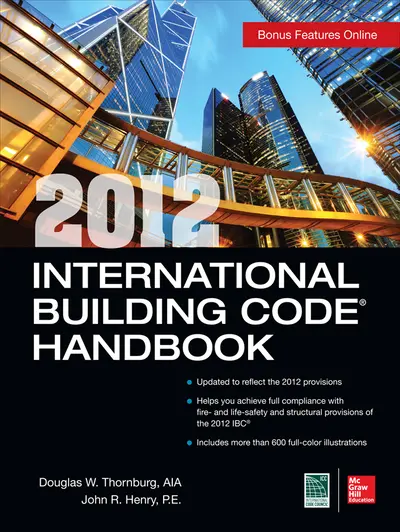My Account Details

ISBN10: 0071801316 | ISBN13: 9780071801317

Step 1 . Download Adobe Digital Editions to your PC or Mac desktop/laptop.
Step 2. Register and authorize your Adobe ID (optional). To access your eBook on multiple devices, first create an Adobe ID at account.adobe.com. Then, open Adobe Digital Editions, go to the Help menu, and select "Authorize Computer" to link your Adobe ID.
Step 3. Open Your eBook. Use Adobe Digital Editions to open the file. If the eBook doesn’t open, contact customer service for assistance.
Publisher's Note: Products purchased from Third Party sellers are not guaranteed by the publisher for quality, authenticity, or access to any online entitlements included with the product. A COMPLETE, FULL-COLOR GUIDE TO THE 2012 INTERNATIONAL BUILDING CODE Updated to reflect the International Code Council 2012 International Building Code, this time-saving resource makes it easy to understand and apply complex IBC requirements and achieve compliance. More than 600 full-color illustrations help to clarify the application and intent of many code provisions, with an emphasis on the structural and fire- and life-safety provisions. The 2012 International Building Code Handbook provides the information you need to get construction jobs done right, on time, and up to the requirements of the 2012 IBC. Achieve Full Compliance with the 2012 IBC: Scope and Administration Definitions Use and Occupancy Classification Special Detailed Requirements Based on Use and Occupancy General Building Heights and Areas Types of Construction Fire and Smoke Protection Features Interior Finishes Fire Protection Systems Means of Egress Accessibility Interior Environment Exterior Walls Roof Assemblies and Rooftop Structures Structural Loads and Design Special Inspections and Tests Soils and Foundations Concrete Aluminum Masonry Steel Wood Glass and Glazing Gypsum Board and Plaster Plastic Plumbing Fixture Count Elevators and Conveying Systems Special Construction Encroachments in the Public Right-of-Way Safeguards During Construction Existing Structures Referenced Standards
Need support? We're here to help - Get real-world support and resources every step of the way.